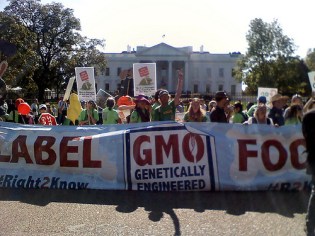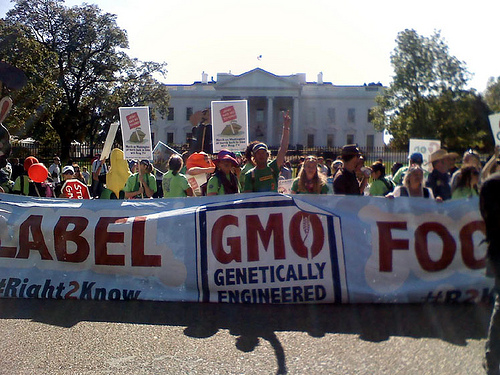
Participants in the Millions Against Monsanto march.
Taking a play from the gay marriage battle, GMO-labeling advocates are taking a state-level approach. The plan has been to pass labeling bills in states where food is on the public’s radar, in order to convince Congress, the Food and Drug Administration (FDA), and United States Department of Agriculture (USDA) that the issue has teeth.
“We want to see it on a national level, but as more states put it up, we’ll get more attention,” says Cary Condotta, the Washington state representative who co-sponsored a GMO-labeling bill.
However, it’s not as simple as pointing to the high percentage of Americans who would like to know when they’re eating genetically modified food. According to a 2010 poll [PDF], 93 percent of Americans were in favor of such labeling.
Thanks to lobbying by seed companies and other agribusiness players, however, state legislators all over the nation have been hitting a wall. Now advocates are joining forces to create a super team in California, in an attempt to get a ballot initiative passed in the state that’s home to 10 percent of all the nation’s grocery stores.
The state-level legislation that could have been
Seventeen states introduced GMO-labeling legislation this session but very few of them appear to have a shot at a vote. With Big Ag providing major campaign contributions, it’s a hard sell. “They know that we’re here on this one issue but Monsanto is there all the time,” says Alexis Baden-Mayer, political director for the Organic Consumers Association (OCA). (The OCA also created the Millions Against Monsanto campaign.)
While many Americans may say they’re pro-GMO labeling, a much smaller number truly understands what genetically modified foods are, let alone how prevalent they are in their diets. In fact, as Tom Laskawy mentioned in a recent post, genetically engineered corn and soy are nearly impossible to avoid if you eat any non-organic processed foods at all.
It certainly doesn’t help when legislators don’t know what the bills are about either. “I bet most people in this legislature didn’t know what a GMO is,” says Condotta, “[So] we knew the likelihood of this legislative session [passing the bill in Washington] was low.”
Washington’s bill has been effectively killed, but Condotta doesn’t see it as a complete loss. It brought attention to the issue, educated the state’s residents on genetic engineering, and it sparked talk of creating GMO-free zones on a county-by-county level in Washington. (Over 40 countries currently have GMO bans or restrictions, which means that Washington’s farmers are worried about their export market if GMOs aren’t contained, Condotta says.)
“The simple answer is that our federal government hasn’t acted,” says Hawaii State Sen. Mike Gabbard in an email. He also introduced labeling legislation this session, but it was never heard in the state’s Agriculture Committee. “It’s going to take the public stepping up and demanding action,” he says. “Back in 2008, I was presented a petition signed by 4,000 Hawaii residents asking for the passage of my ‘whole foods’ labeling bill. Even this wasn’t enough to get my colleagues to act.”
Out of the 17 states with bills introduced, Connecticut and Vermont are the only ones where lawmakers may still have a chance at making something happen through their legislative bodies this year. Baden-Mayer says things in Connecticut are still “too early to call,” whereas Vermont gets a “definitely possible.”
Then there’s the question of if or when Right to Know legislation passes, whether it’ll be held up in court when Big Ag lawyers drag it there — which is likely. Their argument is most likely that food labeling belongs in the federal domain and should not be a state issue.
California’s ballot initiative

Participants in the Millions Against Monsanto march.
As legislation in state houses languishes, some people are proposing another way to get GMO products labeled. Write a bill, collect some signatures, get on the ballot, and lean on the popularity of genetically modified food labeling to get it passed. Sounds simple enough.
To get on the November 2012 ballot, California advocates will need more than 800,000 signatures (to account for ones that get thrown out for a plethora of ineligibility reasons) and have just started collecting them.
But pro-labelers aren’t the only ones pulling out the megaphone. Companies like Monsanto and DuPont will certainly put up a fight. “We have our work cut out for us because there’s this huge misinformation campaign and they’ll try to confuse voters,” says Pamm Larry, the instigator of the ballot initiative. “They’ll try to mislead consumers by saying the cost will go up when in fact, labeling changes happen all the time.”
Ballot initiatives are simple in theory and obscenely expensive in practice because they often rely heavily on television. And as with any David and Goliath story, companies like Monsanto clearly have the dollars to spend on lobbying against the initiative.
Proposition 2, a ballot initiative promising to improve the quality of life of caged farm animals, which passed in 2008, cost supporters $10 million, according to OCA. A 2004 GMO-labeling ballot initiative attempt in Oregon failed when supporters put up only $100,000 compared to the $5.5 million that came form a group calling themselves “Coalition Against the Costly Labeling Law” which included Monsanto, DuPont, Croplife, and Conagra, to name a few.
The California Right to Know Coalition hopes that by combining forces and money from around the country, they’ll outsmart industry effort. “We think we have the very best chance taking this to the voters,” Baden-Mayer says. “It’s a scary thing putting everything into this one, very expensive basket.”
The initiative is on track money- and volunteers-wise at the moment, according to Baden-Mayer.
Pamm Larry is definitely optimistic. “I think it’s going to pass,” she says. Either way, it seemed worth a shot: “Nothing else was working. Legislation was never going anywhere and the [government] agencies weren’t listening to people with their petitions.”



